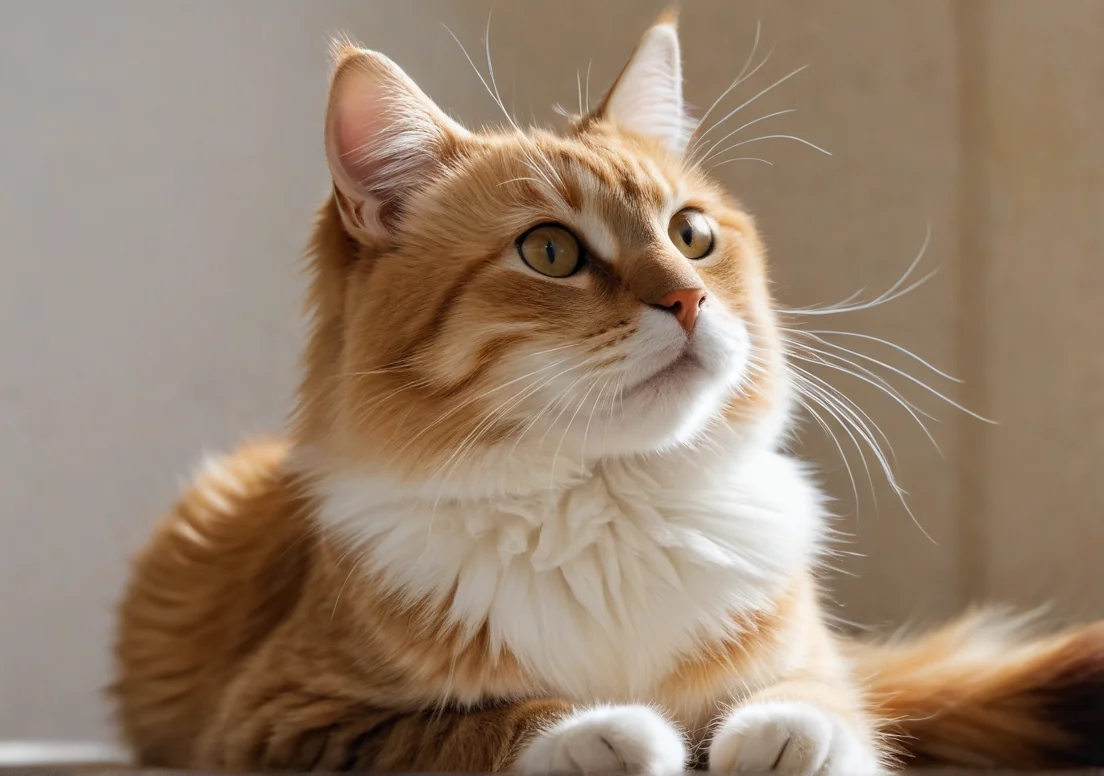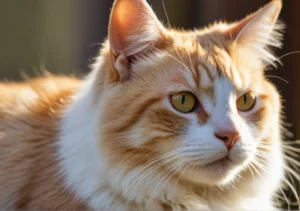Cats are mysterious creatures, their every quirk sparking curiosity among their devoted owners. One of the most bewildering behaviors is when they vibrate their tails, leaving us to wonder what it all means.
When cats vibrate their tails, they are typically expressing excitement, happiness, or sometimes even irritation. This behavior stems from their instinctual communication signals and can indicate various emotions based on the context. But there’s a lot more to this tail vibration than meets the eye—keep reading to unravel the secrets hidden in your feline friend’s tail!

What does tail vibration signify?
A vibrating tail can be an intriguing sight, indicating various emotional states in your cat. When you see this behavior, it’s often a sign that your feline friend is feeling excited or happy. Think of it as their version of a tail-wagging cheer! It can show that they’re delighted to see you, especially after a long day apart or when they’re ready for playtime.
Additionally, tail vibrations might hint at curiosity. If your cat’s tail is vibrating while they’re exploring a new toy or sniffing an interesting spot, they’re absorbing information about their environment. However, on the flip side, tail vibrations can also occur when your cat feels a bit tense or unstable—often a response to being surprised or startled. In those moments, it’s a good idea to observe their overall behavior and surroundings to gauge if they need some space or a comforting touch.
Understanding these nuances can enhance your connection with your cat, making it easier to respond to their needs and emotions.
How is tail vibration different from other tail movements?
Tail movement in cats is a rich language of its own. Vibrating is just one way they communicate, and it’s quite distinct from other tail behaviors.
For example, a twitching tail generally signals agitation or frustration. If you notice your cat’s tail flicking or twitching while they’re focused on something—or even when they’re being petted—it could indicate a bit of annoyance. Conversely, a puffed-up tail often signifies fear or aggression. When a cat fluffs their tail, they’re trying to appear bigger and more intimidating to potential threats.
Here’s a quick reference to help you decipher these behaviors:
- Vibrating: Excitement, happiness, or curiosity.
- Twitching: Agitation or frustration.
- Puffed-up: Fear or aggression.
Recognizing these differences can provide insights into your cat’s mood and help you respond appropriately. Tail movement is an essential part of how your cat communicates with the world, so paying attention can deepen your bond with them.
When do cats usually vibrate their tails?
Tail vibration in cats is often a reflection of their mood and environment. You’ll typically see this behavior when your cat is feeling playful or excited. For instance, during a lively chase of a toy or when they’re exploring a new space, gentle shaking or vibrating of the tail can be a sign of their interest and engagement.
Another common scenario is greetings. When your feline friend sees you after a time apart, they might greet you with a vibrating tail, expressing joy and affection. You’ll often spot this during mealtime, too, as anticipation can trigger excitable vibrations.
Interestingly, tail vibrations can also occur during social interactions with other cats. Kittens often exhibit this behavior while playing, signaling that they’re enjoying their time without any intention of aggression. So, if you notice your cat vibrating their tail in a friendly context, it’s usually a positive sign.
Can tail vibration indicate stress or annoyance?
Not all tail vibrations are signs of happiness. In fact, cats can also vibrate their tails when they’re feeling stressed or annoyed. It’s crucial to pay attention to other body language cues. If your cat’s tail is flicking back and forth rapidly, accompanied by flattened ears or dilated pupils, it could indicate agitation or frustration.
For example, if your cat is cornered by another animal or unexpectedly disturbed during their grooming, the vibration of the tail could signal that they’re feeling threatened. You might see this behavior during vet visits, which can be overwhelming for many cats.
Understanding the context is key. Here are a few specific scenarios where tail vibrations might hint at discomfort:
– Overstimulation: When a cat receives too much petting or attention, they might vibrate their tail as a signal to back off.
– Displacement behavior: If your cat feels trapped or anxious, they may vibrate their tail as a coping mechanism.
If you can recognize these signs and provide space or comfort when needed, you can help your feline friend feel more at ease.
What other body language should you watch for?
Tail vibrations in cats aren’t just a whimsical quirk; they’re often accompanied by other key body language cues that help you decipher your feline’s feelings. For instance, if your cat is moving its tail back and forth while also looking wide-eyed, it’s likely a sign of excitement or curiosity.
Pay attention to their ears too; if they’re pointed forward with a relaxed stance, they’re likely feeling friendly. Conversely, if the ears are pinned back alongside tail vibrations, this can signal annoyance or agitation.
Other cues
- Purring: Often a sign of contentment but can also indicate discomfort in certain situations.
- Body posture: A lowered body with a vibrating tail may indicate fear or uncertainty.
- Facial expressions: Squinty eyes combined with tail vibrations can indicate pleasure, while a tense face could signal stress.
Getting to know these body language combinations can paint a fuller picture of what your cat is truly feeling.
Are there specific breeds that vibrate their tails more?
While tail vibrations can be observed across all breeds, certain feline types might seem to exhibit this behavior more prominently. Breeds like the Bengal, Siamese, and Maine Coon are often noted for their expressive personalities and heightened social behavior, leading to more noticeable tail vibrations.
This isn’t to say all Bengals will vibrate their tails or that other breeds don’t show this behavior at all, but environmental factors and how these breeds engage with humans can heighten this tendency. For instance, Bengals are generally more active and playful, often expressing their excitement with tail vibrations. On the flip side, a more reserved breed like the British Shorthair may not engage in tail vibrations as frequently.
Ultimately, while genetics might play a role, it’s your personal cat’s unique personality and socialization that shape its tail-twitching tendencies.
What does recent research say about cat communication?
Understanding cat communication has taken a more profound turn in recent years, revealing fascinating insights about their tail movements, including vibrations. Studies show that a vibrating tail can indicate a state of excitation or contentment. It’s not just a simple wag; this tail action often correlates with a range of emotions. Researchers highlight that when cats vibrate their tails while interacting with humans or other animals, it’s typically a friendly signal, showing they’re relaxed and comfortable.
Moreover, a study published in the journal Animal Cognition explores how tail movements can convey intentions and emotions. For instance, a slow vibration might suggest your cat is seeking attention or affection, while a faster, more pronounced flick could indicate excitement or playfulness. This complexity makes feline communication richer than we previously understood.
Additionally, tail vibrations are part of their social repertoire. Observations noted in various animal behavior studies suggest that cats might use tail movements to establish a connection with their surroundings or assert their presence in a situation. In multi-cat households, watching how tails interact can provide clues about social dynamics, revealing a lot about how your cats feel around each other.
How can you respond when your cat vibrates its tail?
When you see your cat vibrating its tail, it’s a great opportunity to engage and bond. Here are some tips to respond effectively:
-
Approach calmly : Your cat is likely feeling social, so gently approach without startling it. Calm movements can reinforce your cat’s relaxed state.
-
Offer gentle strokes : If your cat allows it, pet them softly, focusing on areas like the head or along the back. Pay attention to your cat’s reactions to gauge their comfort.
-
Engage with toys : Cats often vibrate their tails when they’re energized. Use toys that allow them to express this excitement – think interactive feather wands or laser pointers.
-
Observe their body language : Look for additional cues. Is your cat purring or kneading? These behaviors alongside tail vibrations suggest they’re in a happy mood.
-
Give them space if needed : Sometimes, cats vibrate their tails when they’re excited but not necessarily looking for interaction. If your cat seems a bit anxious, give them space to calm down.
Understanding these signals goes a long way in strengthening your bond. It creates a connection based on mutual understanding and respect, letting your furry friend know they’re safe and loved in your presence.
Fun facts about cat tail behavior
Cats express their emotions and intentions through their tails in fascinating ways. One of the most intriguing behaviors is tail vibing, which often looks like a gentle shaking or quivering. This behavior might signal a range of feelings, from excitement and affection to a bit of nervousness.
1. Mood Indicator: A vibrating tail typically indicates that a cat is feeling particularly joyful or excited. If your cat’s tail is vibrating while they’re greeting you, they’re likely expressing happiness and affection.
2. Hunting Instincts: Sometimes you’ll notice a cat’s tail vibrating when they’re in full hunter mode, stalking a toy or an unseen target. This slight shake can heighten their focus and excitement before pouncing.
3. Communication Boost: Cats use their tails as a communication tool. The unique motions of their tails, including vibration, help signal their feelings to other cats, giving them quite the visual language.
4. Tail Height Matters: The position of a cat’s tail can provide insight into how they’re feeling. A tail held high with a gentle vibration suggests confidence and friendliness, while a low, vibrating tail could signal submission.
5. Stress Signals: On occasion, if a cat’s tail vibrates or quivers while it’s held low or flicking, it might indicate that they’re feeling stressed or anxious. This is often accompanied by other body language cues.
Cats and their tails have a lot more to them than meets the eye! Understanding the nuances of these behaviors can help deepen your bond with your feline friend. Ultimately, every cat’s personality is unique, so observing their individual quirks will reveal much about their emotional world.
Alex, a passionate animal lover, has experience in training and understanding animal behavior. As a proud pet parent to two dogs and three cats, he founded AnimalReport.net to share insights from animal experts and expand his knowledge of the animal kingdom.




